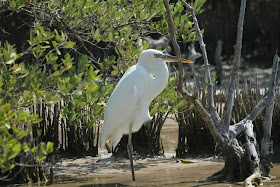As I continue to review the wetland waders photographed in Florida, I have to give a place of prominence to the Cattle Egret, which were just coming into their nuptial splendor.
 |
| Cattle Egret |
Cattle Egrets are native to Africa where they forage alongside camels, ostriches, rhinos, and tortoises - as well as farmers’ tractors. The one occasion in Vermont when I saw the Cattle Egret, it was following a tractor as it plowed a field in Spring.

Cattle Egret
These birds somehow found their way to South America; the first record was in 1877, which may make them officially an exotic (non-native). They arrived in the United States in 1941 and were nesting by 1953. Cattle Egrets spread throughout North America and are common to abundant in some areas.
 |
| Cattle Egret |
When the White Ibis appears in Cape May, it usually creates a stir, with birders carefully reporting its presence and location and pursuing it with considerable intent. This may have been the most common wader I saw in Florida; these birds were wading in wetlands, grazing on lawns, usually in flocks.
 |
| White Ibis |
 |
| White Ibis |
Snowy Egrets have made a wonderful recovery from the devastations of the feather trade a hundred years ago, and are common north and south. There will be additional photos of the nuptial splendor of these dainty birds, but this will do for now.
 |
| Snowy Egret |
True birds of the southern swamps are the solitary and secretive Limpkin (falling taxonomically in the vicinity of the rails and cranes) and the Great White Heron. A bird of the Everglades and Keys, the Great White Heron is currently considered a sub-species of the Great Blue Heron.
 |
| Limpkin |
 |
| Great White Heron |
Good Birding!!









No comments:
Post a Comment